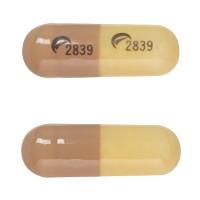Fenofibric Acid Dosage
Medically reviewed by Drugs.com. Last updated on May 21, 2025.
Applies to the following strengths: 45 mg; 135 mg; 35 mg; 105 mg
Usual Adult Dose for:
Additional dosage information:
Usual Adult Dose for Hypertriglyceridemia
Capsules:
- Initial dose: 45 to 135 mg orally once a day
- Maximum dose: 135 mg once a day
Tablets:
- Initial dose: 35 to 105 mg orally per day
- Maximum dose: 105 mg once a day
Comments:
- Dosages should be individualized according to patient response and if necessary, adjusted following repeat lipid determinations at 4 to 8 week intervals.
- Improving glycemic control in diabetic patients showing fasting chylomicronemia will usually obviate the need for pharmacologic intervention.
- Elevated triglycerides (TG) levels of 2000 mg/dL or higher may increase the risk of developing pancreatitis; the effect of therapy reducing this risk has not been adequately studied.
Uses:
- As an adjunct to diet to reduce TG in patients with severe hypertriglyceridemia (500 mg/dL or greater)
Usual Adult Dose for Hyperlipidemia
Capsules:
135 mg orally once a day
Tablets:
105 mg orally once a day
Use: As an adjunct to diet to reduce elevated low-density lipoprotein cholesterol (LDL-C), total cholesterol (Total-C), TG, and apolipoprotein B (Apo B), and to increase high-density lipoprotein cholesterol (HDL-C) in patients with primary hypercholesterolemia or mixed dyslipidemia.
Usual Adult Dose for Dyslipidemia
Capsules:
135 mg orally once a day
Tablets:
105 mg orally once a day
Use: As an adjunct to diet to reduce elevated low-density lipoprotein cholesterol (LDL-C), total cholesterol (Total-C), TG, and apolipoprotein B (Apo B), and to increase high-density lipoprotein cholesterol (HDL-C) in patients with primary hypercholesterolemia or mixed dyslipidemia.
Renal Dose Adjustments
Capsules:
- Mild to moderate renal dysfunction: Initiate at 45 mg orally once a day; doses should be increased only after evaluation of the effects on renal function and lipid levels at this dose
- Severe renal dysfunction: Contraindicated
Tablets:
- Mild to moderate renal dysfunction: Initiate at 35 mg orally once a day; doses should be increased only after evaluation of the effects on renal function and lipid levels at this dose
- Severe renal dysfunction: Contraindicated
Liver Dose Adjustments
Active liver disease (including primary biliary cirrhosis and unexplained persistent liver function abnormalities): Contraindicated
Dose Adjustments
Elderly: Due to the higher incidence of renal impairment in this patient population, dose selection should be based on renal function; monitor renal function during therapy.
Precautions
CONTRAINDICATIONS:
- Hypersensitivity to fenofibric acid or fenofibrate
- Active liver disease, including primary biliary cirrhosis and unexplained persistent liver function abnormalities
- Severe renal impairment, including those receiving dialysis
- Preexisting gallbladder disease
- Nursing mothers
Safety and efficacy have not been established in patients younger than 18 years.
Consult WARNINGS section for additional precautions.
Dialysis
Contraindicated
Other Comments
Administration advice:
- May be taken without regard to meals; swallow whole; do not open, crush, dissolve, or chew tablets or capsules
- Take at least 1 hour before or 4 to 6 hours after a bile acid resin
- Tablets: Therapy should be withdrawn in patients who do not have an adequate response after 2 months of treatment with the maximum dose of 105 mg/day
Storage requirements:
- Protect from light and moisture
General:
- Patients should be placed on an appropriate lipid-lowering diet prior to receiving this drug and should continue this throughout treatment.
- Every attempt should be made to control serum lipids with non-pharmacologic methods prior to initiating drug therapy (e.g., diet, exercise, control of medical problems, dose reduction of medications known to exacerbate hypertriglyceridemia, etc.).
- Drug therapy is not indicated in patients with elevations of chylomicrons and plasma TG, but who have normal levels of very-low density lipoprotein (VLDL).
Monitoring:
- Hematologic: Monitor RBC and WBC counts periodically during the first 12 months of therapy
- Metabolic: Lipid levels prior to initiating therapy and periodically during therapy; monitor HDL-C within the first few months of initiating therapy
- Renal: Monitor renal function periodically in patients with renal insufficiency
- Liver: Monitor liver function (ALT, AST, total bilirubin) at baseline, and periodically during therapy
- Musculoskeletal: Measure creatine phosphokinase levels as appropriate
Patient advice:
- Patients should be advised to continue to follow an appropriate lipid-modifying diet.
- Patients should understand the potential risks of therapy and instructed to report unexplained muscle pain, tenderness, or weakness, especially if accompanied by malaise or fever; to report symptoms of liver injury such as jaundice, abdominal pain, or dark urine.
- Talk to your health care provider if you are pregnant, planning to become pregnant, or breastfeeding; patients should not breastfeed during treatment and for 5 days after the final dose.
More about fenofibric acid
- Check interactions
- Compare alternatives
- Pricing & coupons
- Reviews (25)
- Drug images
- Side effects
- During pregnancy
- Drug class: fibric acid derivatives
- En español
Patient resources
Other brands
Professional resources
Other brands
Related treatment guides
See also:
Further information
Always consult your healthcare provider to ensure the information displayed on this page applies to your personal circumstances.


